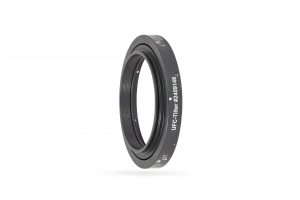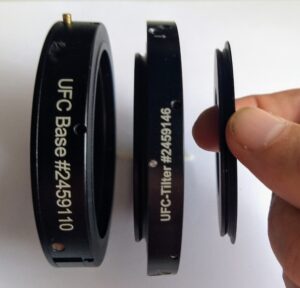The Baader UFC-Tilter is the newest accessory for those using the Baader Universal Filter Changer (UFC). The new Baader UFC-Tilter was developed to help those using the UFC system for astro imaging have the ability to better compensate for image plane tilt.
To understand how the tilter works, here is a brief overview of the UFC system.
Baader Universal Filter Changer
The Baader Universal Filter Changer (UFC for short) is a versatile yet simple system for using, mounting and changing (or swapping) filters in and out of a light path. The UFC can be used for imaging where you may want to swap different filters (e.g. LRGB) between a camera and a telescope but do not want the bulk, or expense, of a filter wheel.
The UFC can be used between a camera and a Celestron RASA 11/14(36) or a Starizona Hyperstar system where the overall size and shape of a filter wheel causes issues. You can also use the UFC for visual purposes where you can easily switch between different color filters between a telescope and an eyepiece.

Image 1 shows the standard “exploded” diagram of the parts that make up the Baader UFC. The company has color-coded the diagram to highlight the main different parts. Currently there are 30 plus parts in the UFC system. The large number of components may seem somewhat overwhelming at first glance but the truth is The Baader UFC is really quite simple. Although looking at Image 1 makes the system look complicated and crowded – you will only really need 4 main parts.
Baader has color coded each section in the diagram above to make it easier to understand. To put it simply, you will need: a camera-side adaptor (part #1) and a telescope-side adaptor (part #2) in addition to the core part of the system called the UFC Base Part #3) and then a sliding filter drawer for your filter (Part #4).
Baader UFC-Tilter
The effects of image tilt can ruin an otherwise great astro photo. Image tilt (or image plane tilt) happens in imaging when an area towards the edge of the field exhibits out-of-focus or imperfect star images and is caused by the image sensor not being perfectly perpendicular to the light path.
Focuser skewness (or “droop”), flattener/corrector lenses, extension adaptors, camera angle adjusters as well as inherent camera sensor tilt in the camera body itself are all causes of image field tilt. Being able to correct for this image plane tilt is important and essential to get perfect focused sharp star images across the field of view.

So Baader developed the Baader UFC-Tilter (Image 2) to help compensate for image plane tilt. This is a telescope-side UFC S70 accessory that is compatible with the entire UFC system and can be used with many refractors and Celestron 11″ and 36cm RASA imaging setups. The unit allows an adjustment tilt shift of the UFC Base (and an attached camera) of up to 1° to compensate for misalignments in the image field. The Tilter is only 9.75-10.50 mm in optical length depending on amount of tilt adjustment made.
The UFC Tilter comes in a Baader Planetarium labelled box with its name, code and description clearly displayed. Inside the box there is the UFC Tilter and a small bag containing six Hex-screws and two Allen keys. The small hex-screws are used to secure any of the UFC S70 telescope-side adapters in place using the smaller of the two Allen keys. The larger Allen-key is used to attach to or remove UFC camera-side adapters from Baader UFC Base (Filter Chamber) telescope-sided S70 dovetail receptor (optical height: 13 mm) if needed.
The Baader UFC-Tilter measures ~91mm in diameter, which is just slightly larger than the UFC Filter Base and adds a mere 87g to the overall payload. On the Tilter’s camera/UFC-Base facing side there is an adjustable (inner) tilt ring with an S70 dovetail for secure attachment into the UFC Base Filter Chamber. Three equally spaced steel pins that go through the outer body of the tilter and into the inner tilt ring act as a “security system” to prevent the tilt ring from falling out. On the telescope side of the Tilter there is a circular opening that accepts any of the UFC’s S70 telescope-side adapters.
Three pairs of screws for adjusting tilt are positioned 120° apart around the outside edge of the unit with tilt adjustment direction arrows clearly labelled, all of which make adjustments easy. One of the issues with some inexpensive tilt adjusters is that the tilt adjusting screws are located on the camera-facing plate so that when a large-body cooled imaging camera (or the UFC Base) is attached, the adjustment screws are obstructed making further adjustment(s) very difficult or impossible and only accessible by removing (and then replacing) the camera or UFC after each adjustment(s) made.
The UFC Tilter functionality is especially useful for the Celestron RASA-community with the RASA 11 and RASA 36 optics where the original “on-telescope” tilt adjustment screws no longer need to be used. Adjustment(s) of the three front-side tilt screws on the RASA lens assembly are required, often with the removal and replacement of the imaging train if these screws are obstructed, but it is still not guaranteed that the adjustments are able to produce a perfect alignment across the full field of view since lateral play in the original manufacturers threads and fittings are just too big for repeated threading and unthreading of cameras and adaptors.
With the Baader UFC Tilter the whole “tilt operation” can be achieved without imaging train removal. Furthermore, the whole of the camera+UFC+UFC-Tilter assembly can be removed from the OTA for safe travel or storage and the next time it is all remounted, none or only small fine adjustments should be required for perfect chip realignment and all done in only a few minutes. So your RASA set up is ready for action as fast as it is when it is taking images.

Attaching the Baader Tilt Adapter to a UFC set up is simple (see Image 3). If you already have a UFC with a telescope-side adapter in place, simply loosen the six retaining screws on the Baader UFC Base (Filter Chamber) telescope-sided S70 dovetail receptor (optical height: 13 mm) , remove the (scope-side) adapter and replace it with the UFC Tilter with its S70 dovetail side facing the UFC Base “S70 port” and then retighten the six Hex screws. Next, add your telescope-side S70 adaptor into the Tilter’s S70 opening and secure with the unit’s six Hex screws.
In use, with all parts of the imaging train in place and attached to a telescope, Baader suggests that the UFC Tilter is adjusted so that the middle of the sensor is set at the required optimum distance from the reducer or corrector (this may require use of spacers such as the UFC fixed or variable length extensions). This is initially achieved by rough adjustment of all three pairs of tilt adjusting screws being moved equally which will allow for about 0.3 mm of inward or outward (camera) travel of the inner tilt ring.
By viewing the resulting image, each corner of the image needs to be addressed separately by working each of the three individual sets of inward/outward adjusting screws for “final tweaking” of each corner by up to an additional of +/-0.2 mm until all of the chip corners in the image show perfectly formed stars. The tilt adjustment screws only need to be tightened with “mild force” as it is two hardened-steel contact surfaces doing the adjustment action and once contact is made, no further movement will occur.
There is also a new Baader M68-Tilter which offers similar functionality as the Baader UFC-Tilter and compatible with the entire Baader M68 adapter system.
You can learn more about these and other Baader products here.
 And to make it easier for you to get the most extensive news, articles and reviews that are only available in the magazine pages of Astronomy Technology Today, we are offering a 1 year magazine subscription for only $6! Or, for an even better deal, we are offering 2 years for only $9. Click here to get these deals which only will be available for a very limited time. You can also check out a free sample issue here.
And to make it easier for you to get the most extensive news, articles and reviews that are only available in the magazine pages of Astronomy Technology Today, we are offering a 1 year magazine subscription for only $6! Or, for an even better deal, we are offering 2 years for only $9. Click here to get these deals which only will be available for a very limited time. You can also check out a free sample issue here.



